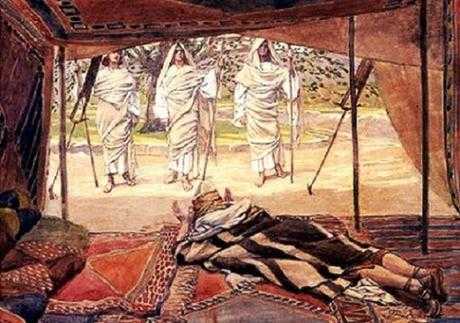Watch
Events
Articles
Market
More
The first verse of Genesis “In the beginning God created the heavens and the earth” tells us the when, the who and the chronological order of the events. The heavenly realm for the divine beings was created first, this is not the same thing we see when we look up into our sky because that’s created later on day four. Exactly how much time elapsed between the completion of the heavenly realm and the beginning of our universe is not given, we don’t need to know. The rest of Genesis chapter 1 is a chronological description for the creation of the universe we live in.



We are called to be a part of God's remnant, to fellowship with Him, as Abraham did at Mamre.
November 12, 2022
TORAH PORTION: "AND HE APPEARED"
PARASHAH: “VAYERA”
Genesis 18:1-22:24
HAFTORAH PORTION
2 Kings 4:1-37
BRIT HADASHAH PORTION
Luke 1:26-38, 24:36-53
Image courtesy of https://m5.paperblog.com/i/151..../1511700/sunday-devo




Thought for Today: Monday November 14:
Let us try together to see things more and more from YHVH’s Perspective. Let the Light of His Presence so fully fill our minds that we view the world through Him. When little things do not go as we had hoped for, let us look to Him light-heartedly and say: [Oh well]. This simple discipline can protect us from being burdened with an accumulation of petty cares and frustrations. If we practise this diligently, we will make a life-changing discover: We will realize that most of the things that worries us are not really important. If we shrug them off immediately, and return our focus to YHVH, we will go through our days with lighter steps and more joyful hearts. When serious problems come our way, we will have more reserves for dealing with them. We will not have squandered our energy on petty problems. We may even reach the point where we can agree with the apostle Paul that all our troubles are light and momentarily, compared with the eternal Glory being achieved by them.



The seventh day is a Sabbath to YHWH your God...
Exodus 20:10
What does it mean to have a #sabbath to YHWH? Is it for his benefit? Is it a Sabbath from his perspective? No, it's a Sabbath in his honor. If you want to honor God, keep the Sabbath on the seventh day as he instructed. What God has made holy, let no man defile.
#shabbat
https://rumble.com/v1u6t0s-a-s....abbath-to-the-lord-e



The Council of Laodicea in about 363 AD said "No others shall sing in the Church, save only the canonical singers, who go up into the ambo and sing from a book." They also said "It is not permitted to hold love feasts, as they are called, in the Lord's Houses, or Churches, nor to eat and to spread couches in the house of God."
LOL. Ok. Sorry, they completely lost me at Canon 15.
So when they said, "Christians must not judaize by resting on the Sabbath...", I feel pretty safe in ignoring them.



Generosity is a prominent characteristic of God's favored people. Consider Abraham, Sarah, Lot, Rebekah, Jacob...
When Eliezer arrived at Laban's home in Haran, Laban recognized that the man was wealthy and welcomed him into his house, but didn't do anything for him. Eliezer had to care for his own camels and men.
Contrast Ephrom (who sold the cave to Abraham), Laban, and Rebekah. Ephrom feigned generosity in order to assimilate Abraham. Laban feigned generosity in order to get some reward from Eliezer and as long as it didn't cost him anything. Rebekah, on the other hand, was generous with no expectation of reward.
Genesis 24


